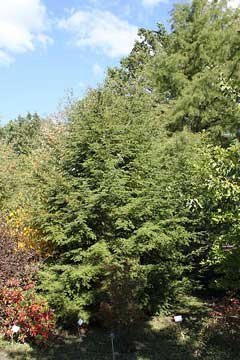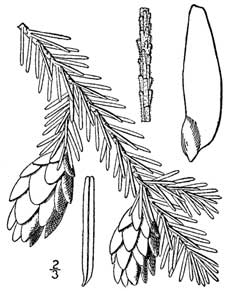 |
|
commons.wikimedia.org/wiki/User:Crusier |
 |
| USDA-NRCS PLANTS Database / Britton, N.L., and A. Brown. 1913. Illustrated flora of the northern states and Canada. Vol. 1: 62 |
Translate this page:
Summary
Bloom Color: Green, Yellow. Main Bloom Time: Early spring, Late spring, Mid spring. Form: Pyramidal.
Physical Characteristics

 Tsuga caroliniana is an evergreen Tree growing to 15 m (49ft) by 8 m (26ft) at a slow rate.
Tsuga caroliniana is an evergreen Tree growing to 15 m (49ft) by 8 m (26ft) at a slow rate.
See above for USDA hardiness. It is hardy to UK zone 6. It is in leaf all year, in flower in April, and the seeds ripen from October to November. The species is monoecious (individual flowers are either male or female, but both sexes can be found on the same plant) and is pollinated by Wind.
Suitable for: light (sandy), medium (loamy) and heavy (clay) soils and prefers well-drained soil. Suitable pH: mildly acid, neutral and basic (mildly alkaline) soils and can grow in very acid soils.
It can grow in full shade (deep woodland) semi-shade (light woodland) or no shade. It prefers moist soil. It can tolerate atmospheric pollution.
UK Hardiness Map
US Hardiness Map
Synonyms
Plant Habitats
Woodland Garden Canopy; Hedge;
Edible Uses
Edible Parts: Inner bark Shoots
Edible Uses: Tea
Inner bark - raw or dried, ground into a powder and then used as a thickening in soups etc or mixed with cereals when making bread[2, 46, 161]. The leaves and twigs yield 'spruce oil', which is used commercially to flavour chewing gum, soft drinks, ice cream etc[183]. A herbal tea is made from the young shoot tips[2, 62, 95, 159, 183]. These tips are also an ingredient of 'spruce beer'[183].
References More on Edible Uses
Medicinal Uses
Plants For A Future can not take any responsibility for any adverse effects from the use of plants. Always seek advice from a professional before using a plant medicinally.
Antipruritic Astringent Birthing aid Diaphoretic Diuretic Kidney
The bark is astringent, diaphoretic and diuretic[21]. A tea made from the inner bark or twigs is helpful in the treatment of kidney or bladder problems, and also makes a good enema for treating diarrhoea[21]. It can also be used as a gargle or mouthwash for mouth and throat problems or externally to wash sores and ulcers[21]. A poultice of the bark has been used to treat itchy armpits[257]. The powdered bark can be put into shoes for tender or sweaty feet or for foot odour[21]. An infusion of the stem tips has been used to treat kidney problems[257]. A decoction of the roots has been used as a birthing aid to help expel the afterbirth[257]. The roots have been chewed in order to treat diarrhoea[257].
References More on Medicinal Uses
The Bookshop: Edible Plant Books
Our Latest books on Perennial Plants For Food Forests and Permaculture Gardens in paperback or digital formats.

Edible Tropical Plants
Food Forest Plants for Hotter Conditions: 250+ Plants For Tropical Food Forests & Permaculture Gardens.
More

Edible Temperate Plants
Plants for Your Food Forest: 500 Plants for Temperate Food Forests & Permaculture Gardens.
More

More Books
PFAF have eight books available in paperback and digital formats. Browse the shop for more information.
Shop Now
Other Uses
Dye Hedge Hedge Resin Rust Tannin Wood
The inner bark has been used to make baskets[257]. A rosy-tan dye can be obtained from the bark[257]. The bark is a source of tannin[257]. All the uses listed below are based on the uses of T. canadensis and reports in [46, 61, 82] that this species has similar uses. Yields a resin similar to Abies balsamea, it is gathered by incisions in the trunk or by boiling the wood[46, 61, 64]. A pitch (called hemlock pitch), is obtained by distillation of the young branches[46]. 'Oil of Hemlock' is distilled from the young branches according to another report[82]. The boiled bark has been used to make a wash to clean rust off iron and steel, and to prevent further rusting[257]. Tolerant of light trimming, plants can be grown as a hedge[81]. This species does not make a good hedge in Britain[200]. Some cultivars can be grown as a ground cover when planted about 1 metre apart each way[208]. 'Pendula' is slow-growing but makes a very good cover[208]. Wood - coarse-grained, light, soft, not strong, brittle, not durable outdoors[21, 46, 61, 82, 171, 229]. Difficult to work because it splits easily[226]. The wood weighs 26lb per cubic foot[235]. The trees do not self-prune and so the wood contains numerous remarkably hard knots that can quickly dull the blade of an axe[226]. A coarse lumber, it is used occasionally for the outside of buildings[21, 46, 61, 82, 171, 229]. It should be used with caution as a fuel for outdoor fires because it can project embers and burning wood several metres from the fire[226].
Special Uses
Hedge Hedge
References More on Other Uses
Cultivation details
Landscape Uses:Hedge, Aggressive surface roots possible, Screen, Specimen. An easily grown plant, it thrives best when growing in a deep well-drained soil in the western parts of Britain where it appreciates the higher rainfall[11]. However, it succeeds in most soils and positions, being especially good on acidic sandy soils[81] but also tolerating some lime[11] so long as there is plenty of humus in the soil[208]. Plants are very shade tolerant when young, but need more sunlight as they grow older[81, 200]. Plants are thin and poor when grown in dry or exposed places[200]. This species is more tolerant of atmospheric pollution than T. canadensis[11]. A slow growing tree in Britain, it requires hot humid summers[200]. It is probably less slow in the far west and in Ireland[185]. Trees have not done well in this country even though they are very cold-tolerant[11]. Plants in this genus are notably resistant to honey fungus[200]. Special Features:Attracts birds, North American native, Inconspicuous flowers or blooms.
References Carbon Farming Information and Carbon Sequestration Information
Temperature Converter
Type a value in the Celsius field to convert the value to Fahrenheit:
Fahrenheit:
The PFAF Bookshop
Plants For A Future have a number of books available in paperback and digital form. Book titles include Edible Plants, Edible Perennials, Edible Trees,Edible Shrubs, Woodland Gardening, and Temperate Food Forest Plants. Our new book is Food Forest Plants For Hotter Conditions (Tropical and Sub-Tropical).
Shop Now
Plant Propagation
Seed - it germinates better if given a short cold stratification[80, 113] and so is best sown in a cold frame in autumn to late winter. It can also be sown in early spring, though it might not germinate until after the next winter. If there is sufficient seed, an outdoor sowing can be made in spring[78]. Pot-grown seedlings are best potted up into individual pots once they are large enough to handle - grow them on in a cold frame and plant them out in early summer of the following year. Trees transplant well when they are up to 80cm tall, but they are best put in their final positions when they are about 30 - 45 cm or less tall, this is usually when they are about 5 - 8 years old[200]. Larger trees will check badly and hardly put on any growth for several years. This also badly affects root development and wind resistance[200].
Other Names
If available other names are mentioned here
Native Range
NORTHERN AMERICA: United States (Georgia (northeast), North Carolina (west), South Carolina, Virginia (southwest), Tennessee)
Weed Potential
Right plant wrong place. We are currently updating this section.
Please note that a plant may be invasive in one area but may not in your area so it's worth checking.
Conservation Status
IUCN Red List of Threatened Plants Status :

Growth: S = slow M = medium F = fast. Soil: L = light (sandy) M = medium H = heavy (clay). pH: A = acid N = neutral B = basic (alkaline). Shade: F = full shade S = semi-shade N = no shade. Moisture: D = dry M = Moist We = wet Wa = water.
Now available:
Food Forest Plants for Mediterranean Conditions
350+ Perennial Plants For Mediterranean and Drier Food Forests and Permaculture Gardens.
[Paperback and eBook]
This is the third in Plants For A Future's series of plant guides for food forests tailored to
specific climate zones. Following volumes on temperate and tropical ecosystems, this book focuses
on species suited to Mediterranean conditions—regions with hot, dry summers and cool, wet winters,
often facing the added challenge of climate change.
Read More
Expert comment
Author
Engelm.
Botanical References
1143200
Links / References
For a list of references used on this page please go here
Readers comment
© 2010, Plants For A Future. Plants For A Future is a charitable company limited by guarantee, registered in England and Wales. Charity No. 1057719, Company No. 3204567.